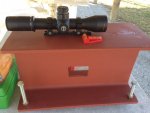I know what the tracking test is and how it works, but was wondering how most here have set it up.
My main problem right now is, without going out and buying some sort of sled or whatever, I have nothing to really 'nail' the scope/rifle down to where my moving the dial wouldn't possibly move the optic thus making the test questionable. I don't think you can just sandbag the rifle because even slight movements will still mess your test up.
What does everyone use that's simple and works? I don't have access to a club with a bench, so this will be in the desert from the ground up.
Secondly, so lets say you do your test and your reticle is missing the 10MIL or 15MIL or whatever mark ever so slightly. Do you simply go to the nearest .1MIL that its off and calculate your actual turret movement from there or is there a way to get super exact with it? Problem would be, how in the hell would I mark where the reticle is on a board 100y away, when I have to get up from the scope/gun to go to the board?
My main problem right now is, without going out and buying some sort of sled or whatever, I have nothing to really 'nail' the scope/rifle down to where my moving the dial wouldn't possibly move the optic thus making the test questionable. I don't think you can just sandbag the rifle because even slight movements will still mess your test up.
What does everyone use that's simple and works? I don't have access to a club with a bench, so this will be in the desert from the ground up.
Secondly, so lets say you do your test and your reticle is missing the 10MIL or 15MIL or whatever mark ever so slightly. Do you simply go to the nearest .1MIL that its off and calculate your actual turret movement from there or is there a way to get super exact with it? Problem would be, how in the hell would I mark where the reticle is on a board 100y away, when I have to get up from the scope/gun to go to the board?


